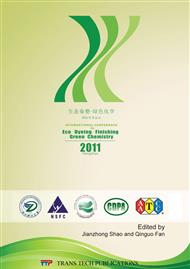[1]
Elmolla M, Schneider R, Development of ecofriendly binders for pigment printing of all types of textile fabrics, Dyes and Pigments. 71 (2006) 130-137.
DOI: 10.1016/j.dyepig.2005.06.017
Google Scholar
[2]
Tomomi Y, Shigeto K, YutakaY. Binder for pigment printing, JP Patent 2, 007, 270, 632. (2007).
Google Scholar
[3]
Levy O, A pigment system to replace dyestuffs, The international Dyer Textile Printer Bleacher & Finisher. 10 (2002) 29-32.
Google Scholar
[4]
Xiao J H, Song X Y, Synthesis of ecofriendly self crosslin-king adhesive and its application in pigment printing, Journal of Dong Hua University (English Edition). 17-4 (2000) 20-33.
Google Scholar
[5]
Yang J J, Zhang J A, Wu Q Y, et al, Ketone-hydrazide crosslinking polyurethane-acrylate pigment printing binder, Journal of Textile Research. 29-2 (2008) 68-72.
Google Scholar
[6]
Xu Q, Synthesis and Application of polyacrylate polymer with core-shell structure pigment printing binder, AnHui University of Science and Technology, Anhui, (2008).
Google Scholar
[7]
Tian M C, Li Y S, The preparation of n-(butoxymethyl) acrylamide and its application in pigment printing adhesive, Journal of Beijing Institute of clothing Technology. 13-2 (1993) 1-7.
Google Scholar
[8]
Pu Z Y, Huang Y H, The preparationg of a nanosize Formaldehyde-free pigment printing and dying adhesives and its application, CN Patent 18511112A. (2006).
Google Scholar
[9]
Galvan S C, Perez J C, Gomez A M, et al, Distribution of emulsified monomers with different water solubility, Colloid and Polymer Science. 268-8 (1990) 778-785.
Google Scholar
[10]
Suresh K I, Jens O, Eckhard B, et al, Mechanistic studies on particle nucleation in the batch emulsion polymerisation of n-butyl acrylate containing multi- functional monomers, Colloid and Polymer Science. 283-1 (2004) 49-57.
DOI: 10.1007/s00396-004-1088-1
Google Scholar
[11]
Wang S T, Gary W P, Characterization of water-soluble oligomer in acrylic acid-styrene emulsion copolymeri- zation, Journal of Applied Polymer Science. 50-12 (1993) 2173-2183.
DOI: 10.1002/app.1993.070501217
Google Scholar
[12]
Brown N R, Frazier E C, Crosslinking poly[(vinyl acetate)-co-N-methylolacrylamide] latex adhesive performance part I: N-methylolacrylamide (NMA) distribution, International Journal of Adhesion & Adhesives. 27 (2007) 547-553.
DOI: 10.1016/j.ijadhadh.2006.10.002
Google Scholar
[13]
Warson H, Finch C A, Applications of synthetic resin latices, Volume 1, fundamental chemistry of latices and applications in adhesives, Chemical Industry Press, Beijing, 2004, p.144.
DOI: 10.1002/pi.1823
Google Scholar
[14]
Zheng Y Y, Hu B H, Lin J H, Influence of urushiol -based emulsifier on the rheological behavior of oil in water raw lacquer emulsion, Acta Polymoerica Sinica. 9 (2008) 920-924.
DOI: 10.3724/sp.j.1105.2008.00920
Google Scholar
[15]
Yoo Y J, Hong G H, Preparation of acrylic copolymers and crosslinking agents and properties as a film, Journal of Applied Polymer Science. 12-3 (2009) 1587-1594.
Google Scholar
[16]
Ludovic V, Pascault J P, Benoit M, et al, Synthesis and photopolymerization of acrylic acrylate copolymers, Journal of Applied Polymer Science. 86-3 (2002) 753-763.
DOI: 10.1002/app.10975
Google Scholar


